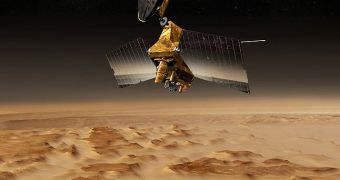Mission controllers at the NASA Jet Propulsion Laboratory (JPL), in Pasadena, California, announce that the High Resolution Imaging Science Experiment (HiRISE) camera aboard the NASA Mars Reconnaissance Orbiter (MRO) has finally been brought back online.
HiRISE is one of the most potent scientific instruments ever deployed to space, having single-handedly produced vast amounts of images of the Red Planet's surface. It collected the most detailed images of Mars to date, contributing extensively to our understanding of the planet.
Over the past two weeks alone, the camera has shut down preemptively twice, in order to avoid any damage. The safety mechanisms were triggered after a data stream commanding an observation session was not properly received and interpreted by a memory module.
This particular component is in charge of controlling one of the 14 charge-coupled device (CCD) electronic detectors that enable HiRISE to collect extreme-detail images of the surface. The level of resolution achieved by this camera exceeds that of most satellite orbiting our own planet.
The glitches that affected its function occurred on August 27 and September 6. After analyzing the telemetry data the MRO sent back, JPL experts compiled lines of code that restored functionality to the main instrument, and enabled it to resume conducting science.
At this point, HiRISE is snapping photos with only 13 of its 14 detectors. According to mission controllers, the second error occurred when the 14th detector was brought back online, following the August 27 glitch.
The team is now working towards developing more in-depth diagnostic tests, in order to figure out precisely what happened to that particular detector. Once the source of the problem is pinned, the team will begin to assess options for brining it back online.
Though it is not desirable, HiRISE could operate using only some of its CCD detectors. However, that will impair its ability to produce the maximum-resolution images experts have come to know it for.
“This isn't a significant loss to the science capability of HiRISE. However, it is a sign that the instrument is aging and could suffer further degradation in the future,” explains Alfred McEwen, the principal investigator of the HiRISE instrument.
The expert, who holds an appointment with the Lunar and Planetary Laboratory at the University of Arizona in Tucson, reminds that MRO has been in orbit around Mars since August 12, 2008, which means that it far exceeded its planned operational life.

 14 DAY TRIAL //
14 DAY TRIAL //